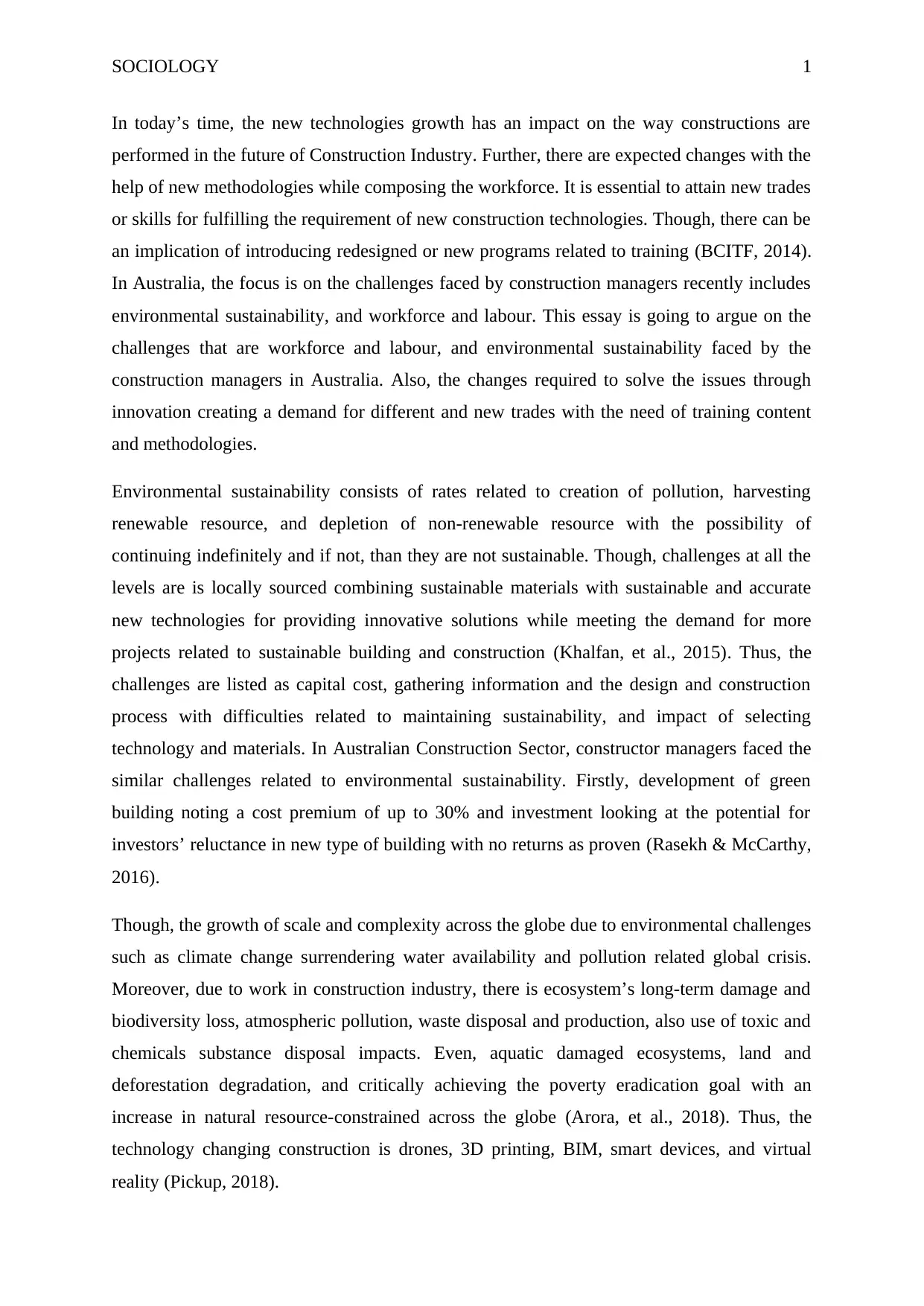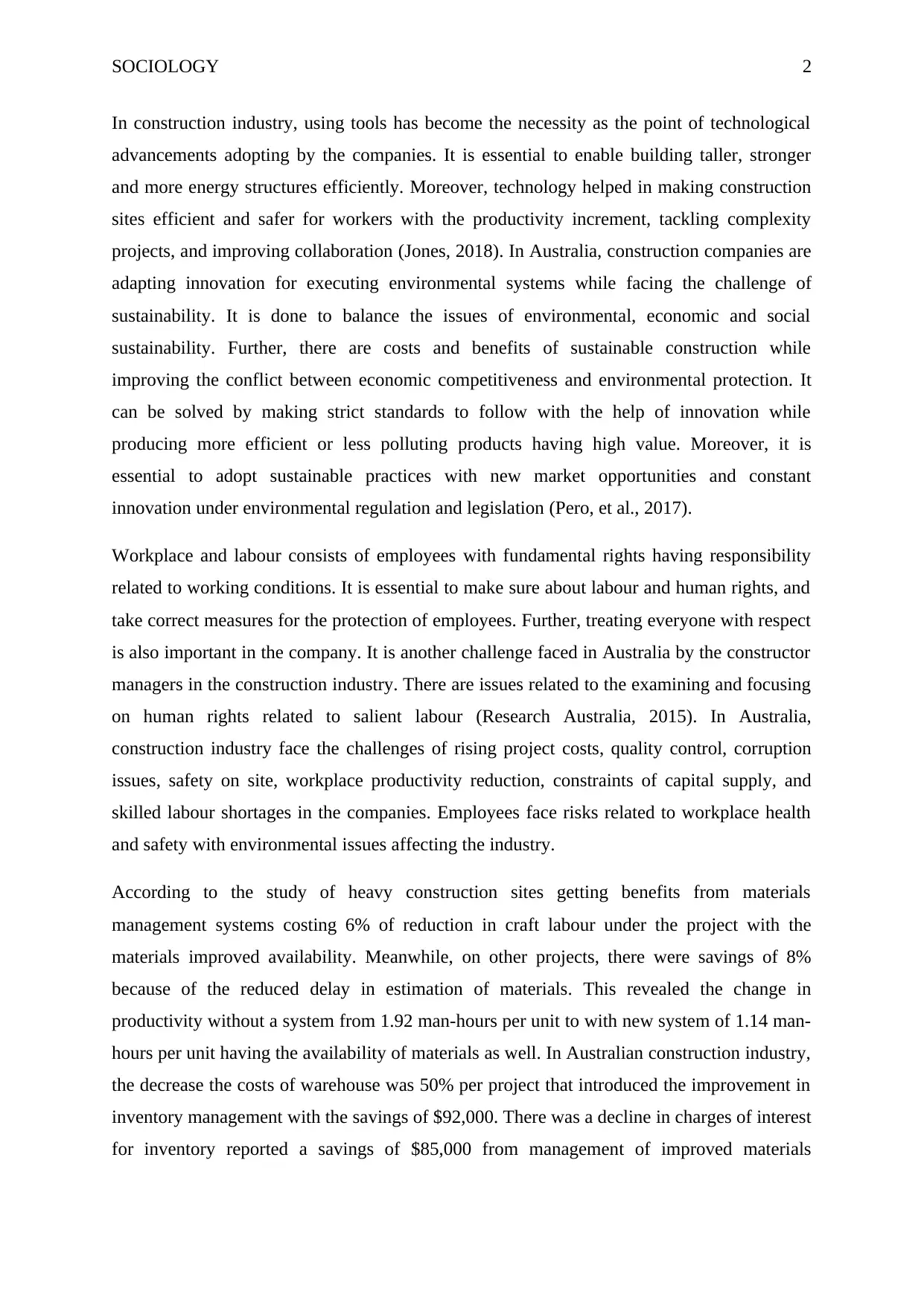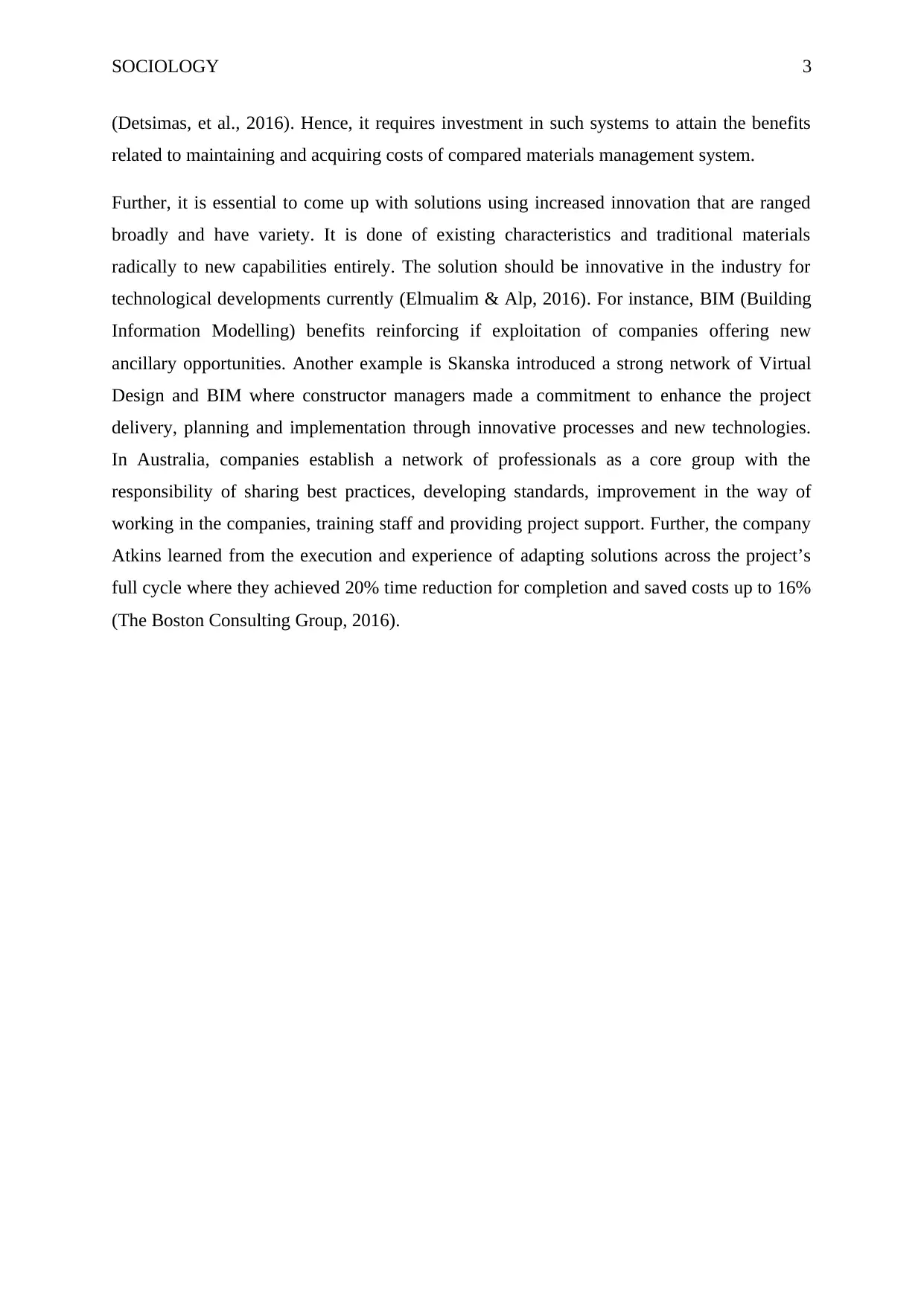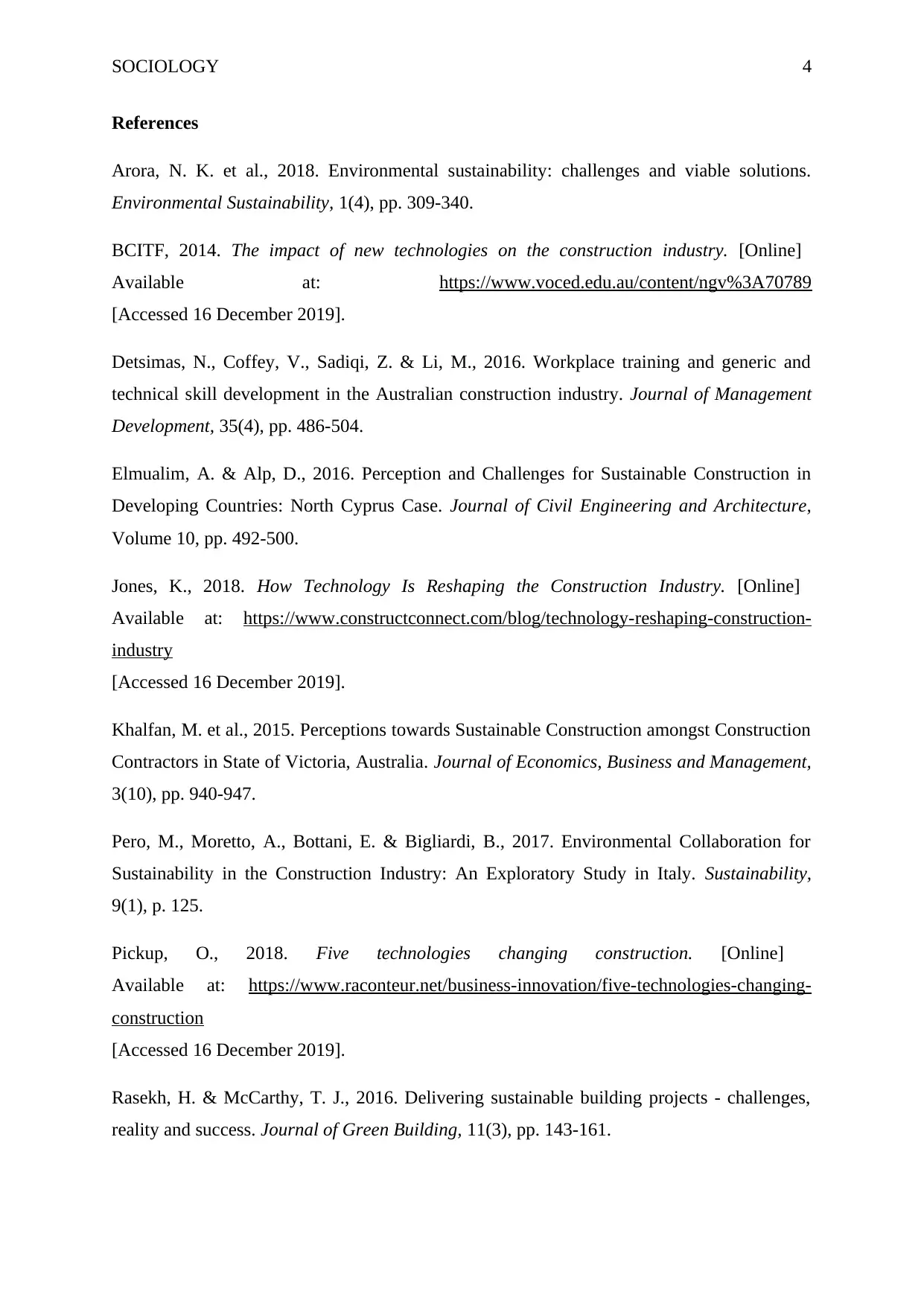Challenges in Australian Construction Management: An Analysis
VerifiedAdded on 2022/09/12
|6
|1564
|24
Essay
AI Summary
This essay addresses the significant challenges confronting construction managers in Australia, particularly focusing on environmental sustainability and workforce and labor issues. It argues that the industry faces hurdles related to pollution, resource depletion, and the need for sustainable practices, including the adoption of new technologies like drones and BIM, and the rising project costs. The essay highlights the importance of addressing workplace and labor concerns, such as human rights and safety, and suggests solutions through innovation, including the development of new training programs and the implementation of advanced technologies. The essay also discusses the benefits of adopting sustainable construction practices and the importance of adapting to new market opportunities and regulations. It references various studies and reports to support its arguments and emphasizes the need for a balanced approach that considers environmental, economic, and social sustainability.

Running Head: SOCIOLOGY 0
Communication Skills for Construction Management
Environment Sustainability & Workforce and Labor
Student Name:
Student University:
Communication Skills for Construction Management
Environment Sustainability & Workforce and Labor
Student Name:
Student University:
Paraphrase This Document
Need a fresh take? Get an instant paraphrase of this document with our AI Paraphraser

SOCIOLOGY 1
In today’s time, the new technologies growth has an impact on the way constructions are
performed in the future of Construction Industry. Further, there are expected changes with the
help of new methodologies while composing the workforce. It is essential to attain new trades
or skills for fulfilling the requirement of new construction technologies. Though, there can be
an implication of introducing redesigned or new programs related to training (BCITF, 2014).
In Australia, the focus is on the challenges faced by construction managers recently includes
environmental sustainability, and workforce and labour. This essay is going to argue on the
challenges that are workforce and labour, and environmental sustainability faced by the
construction managers in Australia. Also, the changes required to solve the issues through
innovation creating a demand for different and new trades with the need of training content
and methodologies.
Environmental sustainability consists of rates related to creation of pollution, harvesting
renewable resource, and depletion of non-renewable resource with the possibility of
continuing indefinitely and if not, than they are not sustainable. Though, challenges at all the
levels are is locally sourced combining sustainable materials with sustainable and accurate
new technologies for providing innovative solutions while meeting the demand for more
projects related to sustainable building and construction (Khalfan, et al., 2015). Thus, the
challenges are listed as capital cost, gathering information and the design and construction
process with difficulties related to maintaining sustainability, and impact of selecting
technology and materials. In Australian Construction Sector, constructor managers faced the
similar challenges related to environmental sustainability. Firstly, development of green
building noting a cost premium of up to 30% and investment looking at the potential for
investors’ reluctance in new type of building with no returns as proven (Rasekh & McCarthy,
2016).
Though, the growth of scale and complexity across the globe due to environmental challenges
such as climate change surrendering water availability and pollution related global crisis.
Moreover, due to work in construction industry, there is ecosystem’s long-term damage and
biodiversity loss, atmospheric pollution, waste disposal and production, also use of toxic and
chemicals substance disposal impacts. Even, aquatic damaged ecosystems, land and
deforestation degradation, and critically achieving the poverty eradication goal with an
increase in natural resource-constrained across the globe (Arora, et al., 2018). Thus, the
technology changing construction is drones, 3D printing, BIM, smart devices, and virtual
reality (Pickup, 2018).
In today’s time, the new technologies growth has an impact on the way constructions are
performed in the future of Construction Industry. Further, there are expected changes with the
help of new methodologies while composing the workforce. It is essential to attain new trades
or skills for fulfilling the requirement of new construction technologies. Though, there can be
an implication of introducing redesigned or new programs related to training (BCITF, 2014).
In Australia, the focus is on the challenges faced by construction managers recently includes
environmental sustainability, and workforce and labour. This essay is going to argue on the
challenges that are workforce and labour, and environmental sustainability faced by the
construction managers in Australia. Also, the changes required to solve the issues through
innovation creating a demand for different and new trades with the need of training content
and methodologies.
Environmental sustainability consists of rates related to creation of pollution, harvesting
renewable resource, and depletion of non-renewable resource with the possibility of
continuing indefinitely and if not, than they are not sustainable. Though, challenges at all the
levels are is locally sourced combining sustainable materials with sustainable and accurate
new technologies for providing innovative solutions while meeting the demand for more
projects related to sustainable building and construction (Khalfan, et al., 2015). Thus, the
challenges are listed as capital cost, gathering information and the design and construction
process with difficulties related to maintaining sustainability, and impact of selecting
technology and materials. In Australian Construction Sector, constructor managers faced the
similar challenges related to environmental sustainability. Firstly, development of green
building noting a cost premium of up to 30% and investment looking at the potential for
investors’ reluctance in new type of building with no returns as proven (Rasekh & McCarthy,
2016).
Though, the growth of scale and complexity across the globe due to environmental challenges
such as climate change surrendering water availability and pollution related global crisis.
Moreover, due to work in construction industry, there is ecosystem’s long-term damage and
biodiversity loss, atmospheric pollution, waste disposal and production, also use of toxic and
chemicals substance disposal impacts. Even, aquatic damaged ecosystems, land and
deforestation degradation, and critically achieving the poverty eradication goal with an
increase in natural resource-constrained across the globe (Arora, et al., 2018). Thus, the
technology changing construction is drones, 3D printing, BIM, smart devices, and virtual
reality (Pickup, 2018).

SOCIOLOGY 2
In construction industry, using tools has become the necessity as the point of technological
advancements adopting by the companies. It is essential to enable building taller, stronger
and more energy structures efficiently. Moreover, technology helped in making construction
sites efficient and safer for workers with the productivity increment, tackling complexity
projects, and improving collaboration (Jones, 2018). In Australia, construction companies are
adapting innovation for executing environmental systems while facing the challenge of
sustainability. It is done to balance the issues of environmental, economic and social
sustainability. Further, there are costs and benefits of sustainable construction while
improving the conflict between economic competitiveness and environmental protection. It
can be solved by making strict standards to follow with the help of innovation while
producing more efficient or less polluting products having high value. Moreover, it is
essential to adopt sustainable practices with new market opportunities and constant
innovation under environmental regulation and legislation (Pero, et al., 2017).
Workplace and labour consists of employees with fundamental rights having responsibility
related to working conditions. It is essential to make sure about labour and human rights, and
take correct measures for the protection of employees. Further, treating everyone with respect
is also important in the company. It is another challenge faced in Australia by the constructor
managers in the construction industry. There are issues related to the examining and focusing
on human rights related to salient labour (Research Australia, 2015). In Australia,
construction industry face the challenges of rising project costs, quality control, corruption
issues, safety on site, workplace productivity reduction, constraints of capital supply, and
skilled labour shortages in the companies. Employees face risks related to workplace health
and safety with environmental issues affecting the industry.
According to the study of heavy construction sites getting benefits from materials
management systems costing 6% of reduction in craft labour under the project with the
materials improved availability. Meanwhile, on other projects, there were savings of 8%
because of the reduced delay in estimation of materials. This revealed the change in
productivity without a system from 1.92 man-hours per unit to with new system of 1.14 man-
hours per unit having the availability of materials as well. In Australian construction industry,
the decrease the costs of warehouse was 50% per project that introduced the improvement in
inventory management with the savings of $92,000. There was a decline in charges of interest
for inventory reported a savings of $85,000 from management of improved materials
In construction industry, using tools has become the necessity as the point of technological
advancements adopting by the companies. It is essential to enable building taller, stronger
and more energy structures efficiently. Moreover, technology helped in making construction
sites efficient and safer for workers with the productivity increment, tackling complexity
projects, and improving collaboration (Jones, 2018). In Australia, construction companies are
adapting innovation for executing environmental systems while facing the challenge of
sustainability. It is done to balance the issues of environmental, economic and social
sustainability. Further, there are costs and benefits of sustainable construction while
improving the conflict between economic competitiveness and environmental protection. It
can be solved by making strict standards to follow with the help of innovation while
producing more efficient or less polluting products having high value. Moreover, it is
essential to adopt sustainable practices with new market opportunities and constant
innovation under environmental regulation and legislation (Pero, et al., 2017).
Workplace and labour consists of employees with fundamental rights having responsibility
related to working conditions. It is essential to make sure about labour and human rights, and
take correct measures for the protection of employees. Further, treating everyone with respect
is also important in the company. It is another challenge faced in Australia by the constructor
managers in the construction industry. There are issues related to the examining and focusing
on human rights related to salient labour (Research Australia, 2015). In Australia,
construction industry face the challenges of rising project costs, quality control, corruption
issues, safety on site, workplace productivity reduction, constraints of capital supply, and
skilled labour shortages in the companies. Employees face risks related to workplace health
and safety with environmental issues affecting the industry.
According to the study of heavy construction sites getting benefits from materials
management systems costing 6% of reduction in craft labour under the project with the
materials improved availability. Meanwhile, on other projects, there were savings of 8%
because of the reduced delay in estimation of materials. This revealed the change in
productivity without a system from 1.92 man-hours per unit to with new system of 1.14 man-
hours per unit having the availability of materials as well. In Australian construction industry,
the decrease the costs of warehouse was 50% per project that introduced the improvement in
inventory management with the savings of $92,000. There was a decline in charges of interest
for inventory reported a savings of $85,000 from management of improved materials
⊘ This is a preview!⊘
Do you want full access?
Subscribe today to unlock all pages.

Trusted by 1+ million students worldwide

SOCIOLOGY 3
(Detsimas, et al., 2016). Hence, it requires investment in such systems to attain the benefits
related to maintaining and acquiring costs of compared materials management system.
Further, it is essential to come up with solutions using increased innovation that are ranged
broadly and have variety. It is done of existing characteristics and traditional materials
radically to new capabilities entirely. The solution should be innovative in the industry for
technological developments currently (Elmualim & Alp, 2016). For instance, BIM (Building
Information Modelling) benefits reinforcing if exploitation of companies offering new
ancillary opportunities. Another example is Skanska introduced a strong network of Virtual
Design and BIM where constructor managers made a commitment to enhance the project
delivery, planning and implementation through innovative processes and new technologies.
In Australia, companies establish a network of professionals as a core group with the
responsibility of sharing best practices, developing standards, improvement in the way of
working in the companies, training staff and providing project support. Further, the company
Atkins learned from the execution and experience of adapting solutions across the project’s
full cycle where they achieved 20% time reduction for completion and saved costs up to 16%
(The Boston Consulting Group, 2016).
(Detsimas, et al., 2016). Hence, it requires investment in such systems to attain the benefits
related to maintaining and acquiring costs of compared materials management system.
Further, it is essential to come up with solutions using increased innovation that are ranged
broadly and have variety. It is done of existing characteristics and traditional materials
radically to new capabilities entirely. The solution should be innovative in the industry for
technological developments currently (Elmualim & Alp, 2016). For instance, BIM (Building
Information Modelling) benefits reinforcing if exploitation of companies offering new
ancillary opportunities. Another example is Skanska introduced a strong network of Virtual
Design and BIM where constructor managers made a commitment to enhance the project
delivery, planning and implementation through innovative processes and new technologies.
In Australia, companies establish a network of professionals as a core group with the
responsibility of sharing best practices, developing standards, improvement in the way of
working in the companies, training staff and providing project support. Further, the company
Atkins learned from the execution and experience of adapting solutions across the project’s
full cycle where they achieved 20% time reduction for completion and saved costs up to 16%
(The Boston Consulting Group, 2016).
Paraphrase This Document
Need a fresh take? Get an instant paraphrase of this document with our AI Paraphraser

SOCIOLOGY 4
References
Arora, N. K. et al., 2018. Environmental sustainability: challenges and viable solutions.
Environmental Sustainability, 1(4), pp. 309-340.
BCITF, 2014. The impact of new technologies on the construction industry. [Online]
Available at: https://www.voced.edu.au/content/ngv%3A70789
[Accessed 16 December 2019].
Detsimas, N., Coffey, V., Sadiqi, Z. & Li, M., 2016. Workplace training and generic and
technical skill development in the Australian construction industry. Journal of Management
Development, 35(4), pp. 486-504.
Elmualim, A. & Alp, D., 2016. Perception and Challenges for Sustainable Construction in
Developing Countries: North Cyprus Case. Journal of Civil Engineering and Architecture,
Volume 10, pp. 492-500.
Jones, K., 2018. How Technology Is Reshaping the Construction Industry. [Online]
Available at: https://www.constructconnect.com/blog/technology-reshaping-construction-
industry
[Accessed 16 December 2019].
Khalfan, M. et al., 2015. Perceptions towards Sustainable Construction amongst Construction
Contractors in State of Victoria, Australia. Journal of Economics, Business and Management,
3(10), pp. 940-947.
Pero, M., Moretto, A., Bottani, E. & Bigliardi, B., 2017. Environmental Collaboration for
Sustainability in the Construction Industry: An Exploratory Study in Italy. Sustainability,
9(1), p. 125.
Pickup, O., 2018. Five technologies changing construction. [Online]
Available at: https://www.raconteur.net/business-innovation/five-technologies-changing-
construction
[Accessed 16 December 2019].
Rasekh, H. & McCarthy, T. J., 2016. Delivering sustainable building projects - challenges,
reality and success. Journal of Green Building, 11(3), pp. 143-161.
References
Arora, N. K. et al., 2018. Environmental sustainability: challenges and viable solutions.
Environmental Sustainability, 1(4), pp. 309-340.
BCITF, 2014. The impact of new technologies on the construction industry. [Online]
Available at: https://www.voced.edu.au/content/ngv%3A70789
[Accessed 16 December 2019].
Detsimas, N., Coffey, V., Sadiqi, Z. & Li, M., 2016. Workplace training and generic and
technical skill development in the Australian construction industry. Journal of Management
Development, 35(4), pp. 486-504.
Elmualim, A. & Alp, D., 2016. Perception and Challenges for Sustainable Construction in
Developing Countries: North Cyprus Case. Journal of Civil Engineering and Architecture,
Volume 10, pp. 492-500.
Jones, K., 2018. How Technology Is Reshaping the Construction Industry. [Online]
Available at: https://www.constructconnect.com/blog/technology-reshaping-construction-
industry
[Accessed 16 December 2019].
Khalfan, M. et al., 2015. Perceptions towards Sustainable Construction amongst Construction
Contractors in State of Victoria, Australia. Journal of Economics, Business and Management,
3(10), pp. 940-947.
Pero, M., Moretto, A., Bottani, E. & Bigliardi, B., 2017. Environmental Collaboration for
Sustainability in the Construction Industry: An Exploratory Study in Italy. Sustainability,
9(1), p. 125.
Pickup, O., 2018. Five technologies changing construction. [Online]
Available at: https://www.raconteur.net/business-innovation/five-technologies-changing-
construction
[Accessed 16 December 2019].
Rasekh, H. & McCarthy, T. J., 2016. Delivering sustainable building projects - challenges,
reality and success. Journal of Green Building, 11(3), pp. 143-161.

SOCIOLOGY 5
Research Australia, 2015. THE ISSUES FACING THE AUSTRALIAN CONSTRUCTION
INDUSTRY. [Online]
Available at: https://www.researchaustralia.com.au/the-issues-facing-the-australian-
construction-industry/
[Accessed 16 December 2019].
The Boston Consulting Group, 2016. Shaping the Future of Construction A Breakthrough in
Mindset and Technology. [Online]
Available at:
http://www3.weforum.org/docs/WEF_Shaping_the_Future_of_Construction_full_report__.p
df
[Accessed 16 December 2019].
Research Australia, 2015. THE ISSUES FACING THE AUSTRALIAN CONSTRUCTION
INDUSTRY. [Online]
Available at: https://www.researchaustralia.com.au/the-issues-facing-the-australian-
construction-industry/
[Accessed 16 December 2019].
The Boston Consulting Group, 2016. Shaping the Future of Construction A Breakthrough in
Mindset and Technology. [Online]
Available at:
http://www3.weforum.org/docs/WEF_Shaping_the_Future_of_Construction_full_report__.p
df
[Accessed 16 December 2019].
⊘ This is a preview!⊘
Do you want full access?
Subscribe today to unlock all pages.

Trusted by 1+ million students worldwide
1 out of 6
Related Documents
Your All-in-One AI-Powered Toolkit for Academic Success.
+13062052269
info@desklib.com
Available 24*7 on WhatsApp / Email
![[object Object]](/_next/static/media/star-bottom.7253800d.svg)
Unlock your academic potential
Copyright © 2020–2025 A2Z Services. All Rights Reserved. Developed and managed by ZUCOL.





